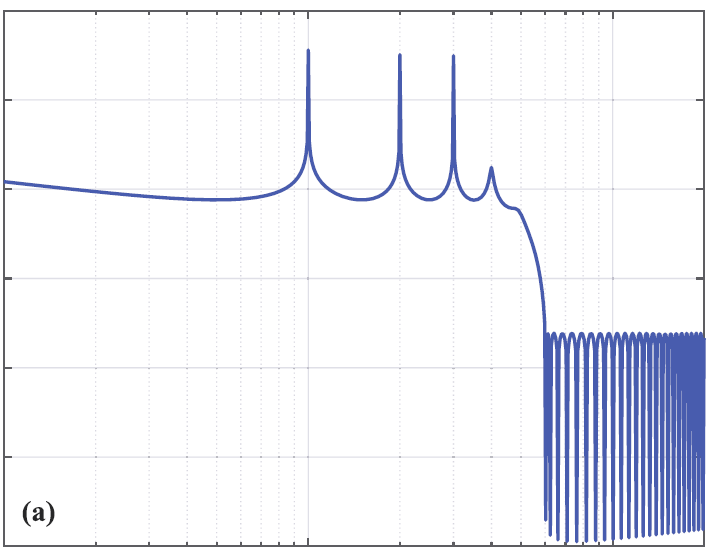Scanning Probe Microscopy
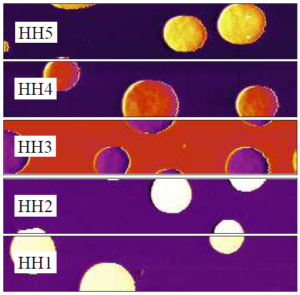
Probe Based Lithography
Probe based lithography involves creating nanometer sized features from photoresist and metal on conducting and semiconducting substrates. Near field optical, electrical and thermal fields are employed in combination with evaporation, etching and electroplating to provide high-speed alternatives for mask-less nanofabrication.
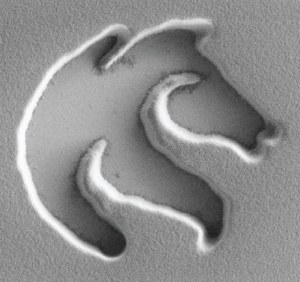
Nanopositioning
A nanopositioner is a electromechanical device for moving objects in three dimensions with atomic, or sub-atomic resolution. Nanopositioners are employed in applications such as imaging, fabrication and optics. This field encompasses mechanical design, sensor design, and control theory. More details.
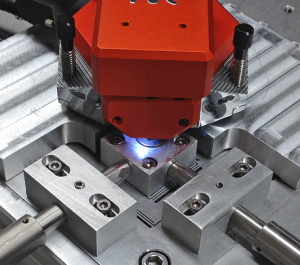
Electroactive Optics
Piezoelectric actuators can be combined with mirrors, lenses and objectives to actively control the path and properties of an optical field or laser beam. High speed electro-optics are required for precision lasers, maskless lithography, and microscopy.
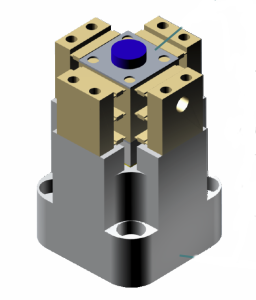
Precision Sensors
This project aims to study the fundamental limitations of capacitive, optical and magnetic position sensors. New techniques are under development to provide sub-atomic resolution over extremely wide bandwidth.
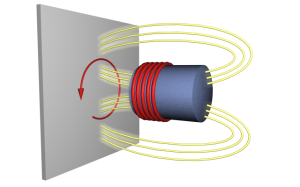
Biomedical Devices
An endoscopic pill robot is being developed for noninvasive imaging and intervention. The robot can be swallowed and includes power transmission, 6-Dimensional localization, and locomotion.
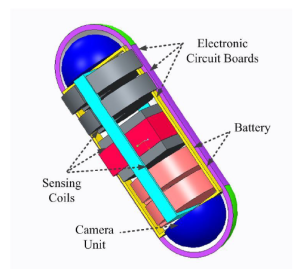
Piezo Actuators and Amplifiers
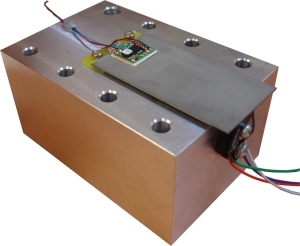
Piezo bender actuator with integrated 200V power electronics
Piezo Robotics
Due to their compact size and high efficiency, piezoelectric actuators are ideal for micro-actuation in bio-inspired robotics. This project is developing actuators and mechanics for a piezoelectric dragon-fly robot.
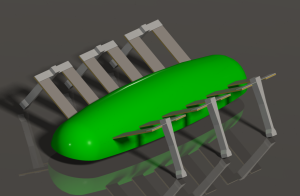
Ragazzon, M. R. P.; Messineo, S.; Gravdahl, J. T.; Harcombe, D. M.; Ruppert, M. G.
The Generalized Lyapunov Demodulator: High-Bandwidth, Low-Noise Amplitude and Phase Estimation Journal Article
In: IEEE Open Journal of Control Systems, 2022.
@article{Ragazzon2022,
title = {The Generalized Lyapunov Demodulator: High-Bandwidth, Low-Noise Amplitude and Phase Estimation},
author = {M. R. P. Ragazzon and S. Messineo and J. T. Gravdahl and D. M. Harcombe and M. G. Ruppert},
doi = {10.1109/OJCSYS.2022.3181111},
year = {2022},
date = {2022-06-08},
urldate = {2022-06-08},
journal = {IEEE Open Journal of Control Systems},
abstract = {Effective demodulation of amplitude and phase is a requirement in a wide array of applications. Recent efforts have increased the demodulation performance, in particular, the Lyapunov demodulator allows bandwidths up to the carrier frequency of the signal. However, being inherently restricted to first-order filtering of the input signal, it is highly sensitive to frequency components outside its passband region. This makes it unsuitable for certain applications such as multifrequency atomic force microscopy (AFM). In this article, the structure of the Lyapunov demodulator is transformed to an equivalent form and generalized by exploiting the internal model principle. The resulting generalized Lyapunov demodulator structure allows for arbitrary filtering order and is easy to implement, requiring only a bandpass filter, a single integrator, and two nonlinear transformations. The generalized Lyapunov demodulator is implemented experimentally on a field-programmable gate array (FPGA). Then it is used for imaging in an AFM and benchmarked against the standard Lyapunov demodulator and the widely used lock-in amplifier. The lock-in amplifier achieves great noise attenuation capabilities and off-mode rejection at low bandwidths, whereas the standard Lyapunov demodulator is shown to be effective at high bandwidths. We demonstrate that the proposed demodulator combines the best from the two state-of-the-art demodulators, demonstrating high bandwidths, large off-mode rejection, and excellent noise attenuation simultaneously.},
keywords = {},
pubstate = {published},
tppubtype = {article}
}
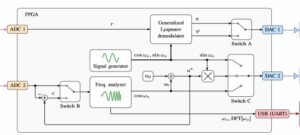
Xavier, M. S.; Tawk, C. D.; Zolfagharian, A.; Pinskier, J.; Howard, D.; Young, T.; Lai, J.; Harrison, S.; Yong, Y. K.; Bodaghi, M.; Fleming, A. J.
Soft Pneumatic Actuators: A Review of Design, Fabrication, Modeling, Sensing, Control and Applications Journal Article
In: IEEE Access, vol. 10, pp. 59442-59485, 2022, ISSN: 2169-3536.
@article{J22h,
title = {Soft Pneumatic Actuators: A Review of Design, Fabrication, Modeling, Sensing, Control and Applications},
author = {M. S. Xavier and C. D. Tawk and A. Zolfagharian and J. Pinskier and D. Howard and T. Young and J. Lai and S. Harrison and Y. K. Yong and M. Bodaghi and A. J. Fleming},
url = {https://www.precisionmechatronicslab.com/wp-content/uploads/2023/02/J22h-1.pdf},
doi = {10.1109/ACCESS.2022.3179589},
issn = {2169-3536},
year = {2022},
date = {2022-06-02},
urldate = {2022-06-02},
journal = {IEEE Access},
volume = {10},
pages = {59442-59485},
abstract = {Soft robotics is a rapidly evolving field where robots are fabricated using highly deformable materials and usually follow a bioinspired design. Their high dexterity and safety makes them ideal for applications such as gripping, locomotion, and biomedical devices, where the environment is highly dynamic and sensitive to physical interaction. Pneumatic actuation remains the dominant technology in soft robotics due to its low cost and mass, fast response time, and easy implementation. Given the significant number of publications in soft robotics over recent years, newcomers and even established researchers may have difficulty assessing the state of the art. To address this issue, this article summarizes the development of soft pneumatic actuators and robots up until the date of publication. The scope of this article includes the design, modeling, fabrication, actuation, characterization, sensing, control, and applications of soft robotic devices. In addition to a historical overview, there is a special emphasis on recent advances such as novel designs, differential simulators, analytical and numerical modeling methods, topology optimization, data-driven modeling and control methods, hardware control boards, and nonlinear estimation and control techniques. Finally, the capabilities and limitations of soft pneumatic actuators and robots are discussed and directions for future research are identified.},
keywords = {},
pubstate = {published},
tppubtype = {article}
}
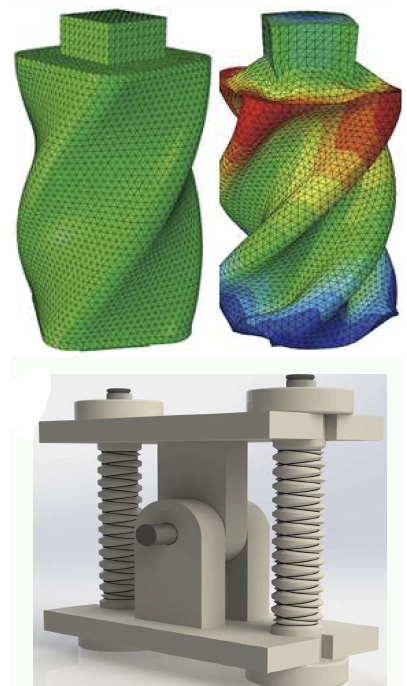
Jidling, C.; Fleming, A. J.; Wills, A. G.; Schon, T. B.
Memory efficient constrained optimization of scanning-beam lithography Journal Article
In: Optics Express, vol. 30, no. 12, pp. 20564–20579, 2022, ISSN: 1094-4087.
@article{J22g,
title = {Memory efficient constrained optimization of scanning-beam lithography},
author = {C. Jidling and A. J. Fleming and A. G. Wills and T. B. Schon},
url = {https://www.precisionmechatronicslab.com/wp-content/uploads/2022/05/J22g.pdf},
doi = {10.1364/OE.457334},
issn = {1094-4087},
year = {2022},
date = {2022-06-01},
journal = {Optics Express},
volume = {30},
number = {12},
pages = {20564--20579},
abstract = {This article describes a memory efficient method for solving large-scale optimization problems that arise when planning scanning-beam lithography processes. These processes require the identification of an exposure pattern that minimizes the difference between a desired and predicted output image, subject to constraints. The number of free variables is equal to the number of pixels, which can be on the order of millions or billions in practical applications. The proposed method splits the problem domain into a number of smaller overlapping subdomains with constrained boundary conditions, which are then solved sequentially using a constrained gradient search method (L-BFGS-B). Computational time is reduced by exploiting natural sparsity in the problem and employing the fast Fourier transform for efficient gradient calculation. When it comes to the trade-off between memory usage and computational time we can make a different trade-off compared to previous methods, where the required memory is reduced by approximately the number of subdomains at the cost of more computations. In an example problem with 30 million variables, the proposed method reduces memory requirements by 67%; but increases computation time by 27%. Variations of the proposed method are expected to find applications in the planning of processes such as scanning laser lithography, scanning electron beam lithography, and focused ion beam deposition, for example.},
keywords = {},
pubstate = {published},
tppubtype = {article}
}
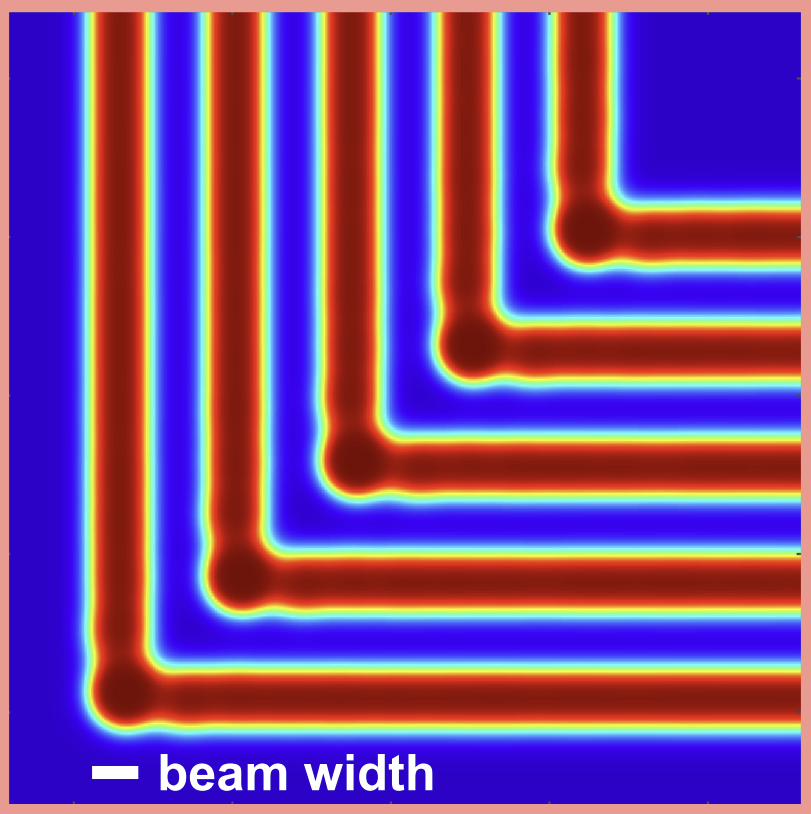
Xavier, M. S.; Fleming, A. J.; Yong, Y. K.
Nonlinear Estimation and Control of Bending Soft Pneumatic Actuators Using Feedback Linearization and UKF Journal Article
In: IEEE/ASME Transactions on Mechatronics, vol. 27, iss. 4, pp. 1919-1927, 2022, ISSN: 1083-4435.
@article{J22e,
title = {Nonlinear Estimation and Control of Bending Soft Pneumatic Actuators Using Feedback Linearization and UKF },
author = {M. S. Xavier and A. J. Fleming and Y. K. Yong},
url = {https://www.precisionmechatronicslab.com/wp-content/uploads/2023/02/J22e-1.pdf},
doi = {10.1109/TMECH.2022.3155790},
issn = {1083-4435},
year = {2022},
date = {2022-06-01},
urldate = {2022-06-01},
journal = {IEEE/ASME Transactions on Mechatronics},
volume = {27},
issue = {4},
pages = {1919-1927},
abstract = {In this article, we combine nonlinear estimation and control methods for precise bending angle control in soft pneumatic actuators driven by a pressure source and single low-cost ON/OFF solenoid valve. First, a complete model for the soft actuator is derived, which includes both the motion and pressure dynamics. An unscented Kalman filter (UKF) is used to estimate the velocity state and filter noisy measurements from a pressure sensor and an embedded resistive flex sensor. Then, a feedback linearization approach is used with pole placement and linear quadratic regulator (LQR) controllers for bending angle control. To compensate for model uncertainties and improve reference tracking, integral action is incorporated to both controllers. The closed-loop performance of the nonlinear estimation and control approach is experimentally evaluated with a soft pneumatic network actuator. The simulation and experimental results show that the UKF provides accurate state estimation from noisy sensor measurements. The results demonstrate the effectiveness and robustness of the proposed observer-based nonlinear controllers for bending angle trajectory tracking.},
keywords = {},
pubstate = {published},
tppubtype = {article}
}
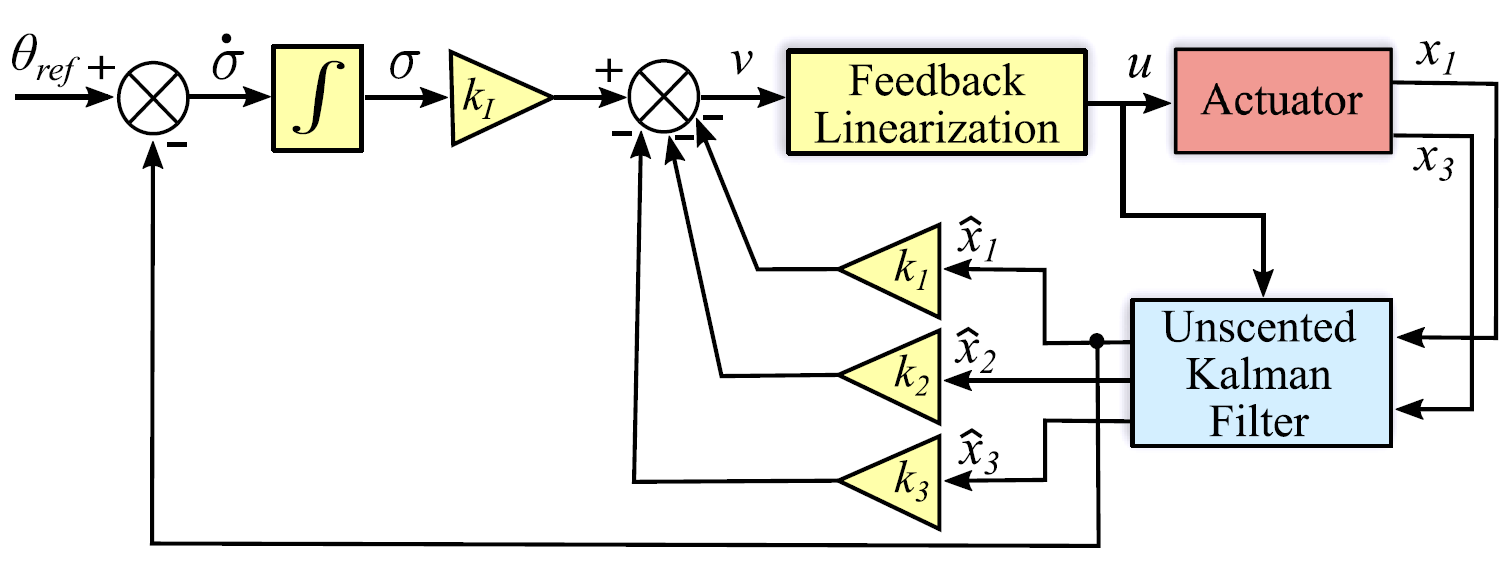
Li, Linlin; Fleming, A. J.; Yong, Y. K.; Aphale, S. S.; Zhu, LiMin
High Performance Raster Scanning of Atomic Force Microscopy Using Model-free Repetitive Control Journal Article
In: Mechanical Systems and Signal Processing, vol. 173, no. 109027, 2022, ISSN: 0888-3270.
@article{J22f,
title = {High Performance Raster Scanning of Atomic Force Microscopy Using Model-free Repetitive Control},
author = {Linlin Li and A. J. Fleming and Y. K. Yong and S. S. Aphale and LiMin Zhu},
url = {https://www.precisionmechatronicslab.com/wp-content/uploads/2022/08/J22f.pdf},
doi = {10.1016/j.ymssp.2022.109027},
issn = {0888-3270},
year = {2022},
date = {2022-05-01},
urldate = {2022-05-01},
journal = {Mechanical Systems and Signal Processing},
volume = {173},
number = {109027},
abstract = {The image quality of an atomic force microscope depends on the tracking performance of the lateral X and Y axis positioner. To reduce the requirement for accurate system models, this article describes a method based on Model free Repetitive Control (MFRC) for high performance control of fast triangular trajectories in the X-axis, and a slow staircase trajectory in the Y-axis, while simultaneously achieving coupling compensation from the X-axis to Y-axis. The design and stability analysis of the MFRC scheme are presented in detail. The tracking results are experimen tally evaluated with a range of different load conditions, showing the efficacy of the method with large variations in plant dynamics. To address the coupling from the X-axis to the Y-axis while tracking the non-periodic staircase trajectories, a pre-learning step is used to generate the compensation signals, which is combined in a feedforward manner in real-time implementations. This approach is also applied to address the problem of longer convergence if needed. Experimental tracking control and coupling compensation is demonstrated on a commercially available piezoelectric-actuated scanner. The proposed method reduces the root-mean-square tracking from 191.4 nm in open loop or 194.6 nm with PI control, to 2.8 nm with PI+MFRC control at 100 Hz scan rate, which demonstrates the significant improvement achieved by the proposed method.},
keywords = {},
pubstate = {published},
tppubtype = {article}
}
